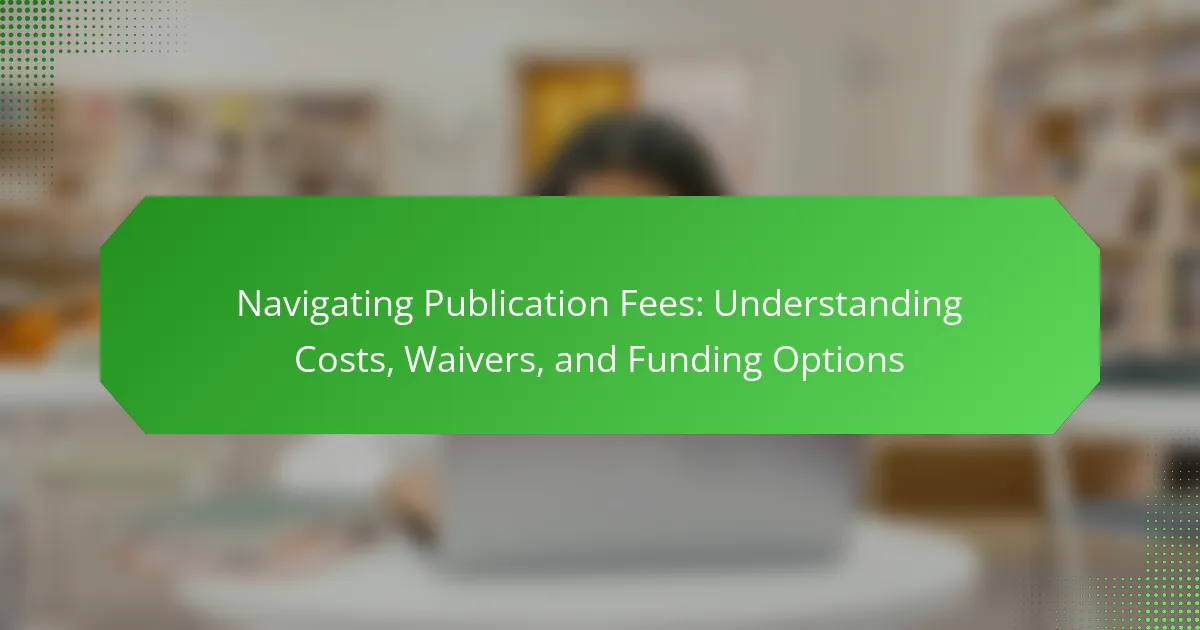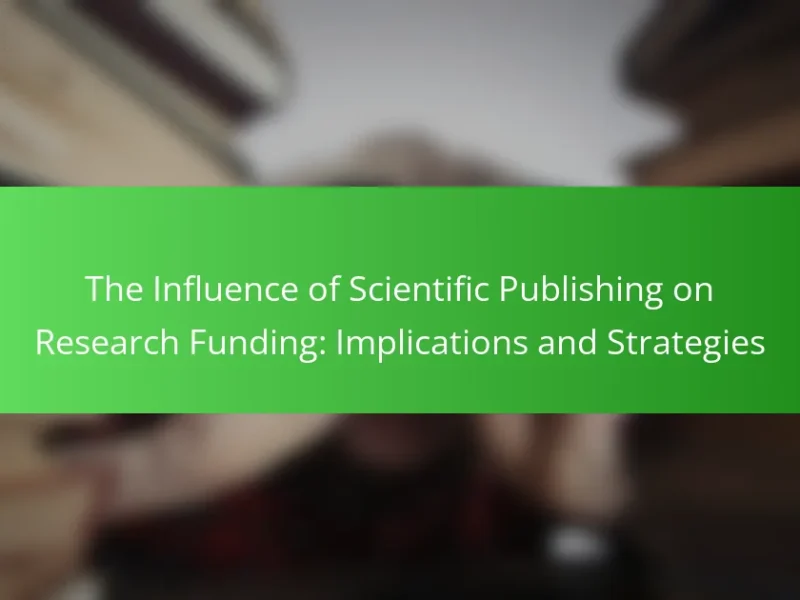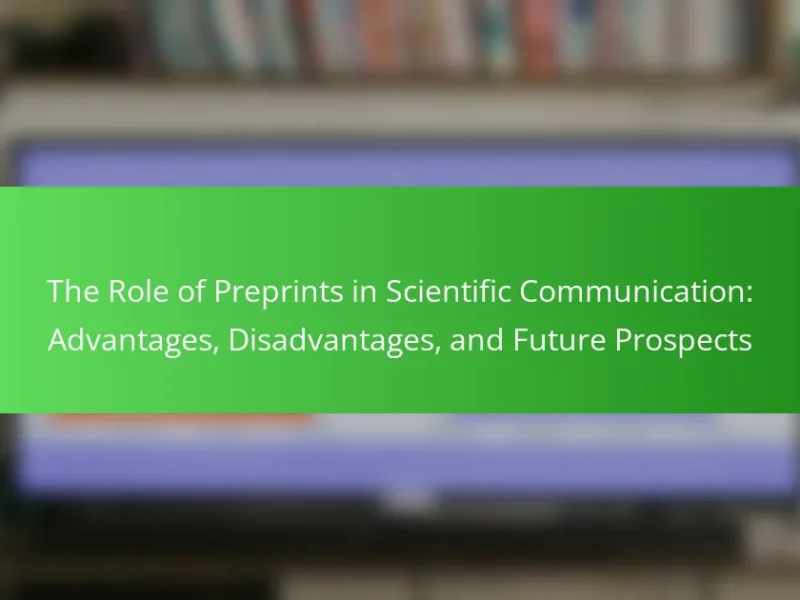Publication fees are charges imposed by journals or publishers for processing and disseminating research articles. These fees, which can include article processing charges (APCs), submission fees, and page fees, vary widely based on the journal’s reputation and publication type. Understanding these costs is essential for researchers as they select venues for their work. Additionally, options for waivers and funding, such as institutional support and grants, can help mitigate the financial burden of publication fees. This article provides a comprehensive overview of publication fees, their types, and available financial assistance for researchers.

What are Publication Fees?
Publication fees are charges imposed by journals or publishers for processing and disseminating research articles. These fees cover various costs, including editorial work, peer review, and online hosting. They can vary widely depending on the journal’s reputation and the type of publication. Some journals may charge thousands of dollars, while others have lower or no fees. Many open access journals rely on publication fees to provide free access to articles. Additionally, some institutions or funding bodies may offer financial support to cover these costs. Understanding publication fees is crucial for researchers when selecting where to submit their work.
How are Publication Fees determined?
Publication fees are determined based on several factors including journal policies, article type, and funding sources. Each journal sets its own fee structure, which can vary widely. Factors such as the length of the article, the inclusion of color figures, and open access options can influence the total fee. Additionally, some journals offer discounts or waivers based on the authors’ affiliations or financial situations. Research indicates that many institutions have agreements with publishers to reduce costs for their researchers. These agreements can significantly affect the fees charged to authors. Overall, understanding the specific policies of the journal in question is essential for accurately determining publication fees.
What factors influence the cost of Publication Fees?
The cost of publication fees is influenced by several factors. Journal reputation plays a significant role; high-impact journals often charge more. The type of publication also affects fees; open access publications generally have higher costs than traditional subscriptions. Word count can influence pricing; longer articles may incur additional fees. The field of study matters; specialized journals might have different pricing structures. Geographic location of the author can impact costs, as fees vary by region. Additionally, funding availability may reduce out-of-pocket expenses for authors. Lastly, the presence of waivers or discounts for specific demographics can also affect the final fee.
How do different types of publications affect fees?
Different types of publications significantly affect fees. Academic journals often charge higher fees due to rigorous peer review processes and higher production costs. Open-access publications typically require authors to pay publication fees upfront, which can range from hundreds to thousands of dollars. In contrast, traditional subscription-based journals may not charge authors directly but instead rely on institutional subscriptions for revenue. Additionally, fees can vary based on the publication’s impact factor, with higher-impact journals generally imposing greater costs. Research shows that fees for open-access journals can be as high as $5,000, while some subscription journals may have no author fees at all. This variability in publication types directly influences the financial obligations for authors.
Why do Publication Fees exist?
Publication fees exist to cover the costs associated with the peer review and publication process. These fees ensure that journals can maintain high editorial standards. They support the operational expenses of publishing, including staff salaries and infrastructure. Many academic journals operate on a subscription model, where fees help offset the costs of making research accessible. In some cases, publication fees also contribute to open access initiatives. This allows research to be freely available to the public. Consequently, publication fees play a crucial role in sustaining the academic publishing ecosystem.
What services do Publication Fees cover?
Publication fees cover a range of services associated with the publication process. These services typically include editorial management, peer review, and typesetting. They also encompass online hosting and archiving of the published work. Additionally, publication fees may cover marketing and distribution efforts to enhance visibility. Some journals use these fees to support open access initiatives, allowing wider public access to research. The specific services can vary by journal, so it’s important to check individual publication guidelines for details.
How do Publication Fees vary across disciplines?
Publication fees vary significantly across academic disciplines. In the sciences, fees can range from $1,500 to $5,000. In contrast, humanities journals often charge lower fees, typically between $500 and $2,000. Social sciences may see fees around $1,000 to $3,000. These variations arise from differences in publication models and funding sources. For example, open-access journals in STEM fields frequently have higher fees due to production costs. Additionally, some disciplines have more institutional support for publication, influencing fee structures. Overall, the discipline greatly impacts the cost of publishing research.
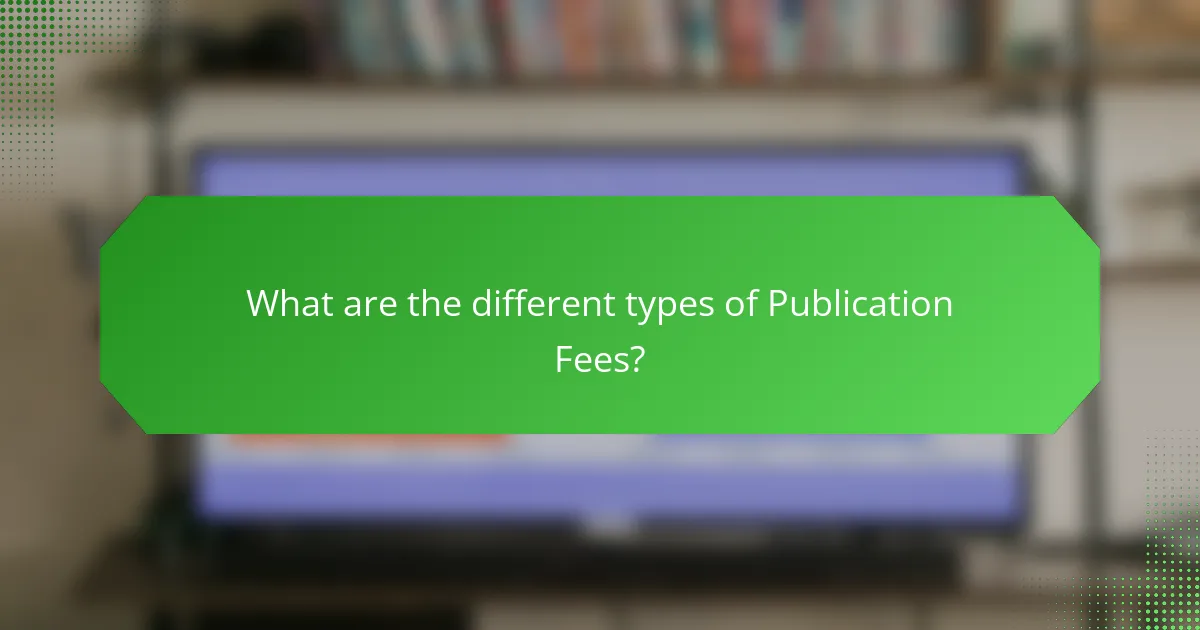
What are the different types of Publication Fees?
There are several types of publication fees. These include article processing charges (APCs), submission fees, and page fees. Article processing charges are paid to make research openly accessible. Submission fees are charged when a manuscript is submitted for review. Page fees apply to the number of pages in a published article. Other fees may include color figure fees and reprint fees. Each type of fee varies by journal and publisher. Understanding these fees is crucial for budgeting research costs.
What are Article Processing Charges (APCs)?
Article Processing Charges (APCs) are fees charged by publishers to cover the costs of publishing an article in open access journals. These charges are typically paid by authors or their institutions. APCs enable the journal to make the article freely available to readers. The fees can vary widely depending on the journal and its publishing model. For instance, some journals may charge several thousand dollars for publication. APCs support editorial services, peer review, and online hosting. Many funding agencies provide grants to help cover these costs. Understanding APCs is crucial for authors navigating publication fees.
How do APCs differ between open access and subscription models?
Article Processing Charges (APCs) differ significantly between open access and subscription models. In open access publishing, APCs are typically paid by authors to make their work freely accessible to the public. These charges can range from a few hundred to several thousand dollars, depending on the journal’s reputation and impact factor. Conversely, in subscription models, authors usually do not pay APCs. Instead, readers or institutions pay subscription fees to access the content. This model often limits access to those who can afford subscriptions, while open access aims to democratize information. The key distinction lies in who bears the cost: authors pay APCs in open access, while readers pay in subscription models.
What should authors know about APC payment timelines?
Authors should know that Article Processing Charge (APC) payment timelines vary by publisher. Typically, payment is required upon acceptance of the manuscript. Some publishers may offer a grace period for payment after acceptance. Authors should confirm specific timelines with their chosen journal. Delays in payment can affect the publication process. Timely payment ensures that the article moves through the production stages without interruption. Many publishers provide detailed payment instructions on their websites. Understanding these timelines helps authors plan for funding and budget accordingly.
What are Submission Fees?
Submission fees are charges imposed by publishers when authors submit their manuscripts for consideration. These fees can vary widely depending on the journal or publisher. They are often used to cover administrative costs associated with the review process. Submission fees may also help maintain the journal’s operations. Some journals waive these fees for authors from low-income countries or under certain circumstances. Understanding submission fees is crucial for authors budgeting for publication. In some cases, these fees can be a barrier to publication for researchers with limited funding.
What do Submission Fees typically cover?
Submission fees typically cover the administrative costs associated with processing a manuscript. These fees support editorial review, peer review coordination, and manuscript handling. They may also contribute to publishing infrastructure and online hosting. Additionally, submission fees can help cover the costs of maintaining journal quality and standards. In some cases, they are used for editorial staff salaries and operational expenses. The fees ensure that the publication process runs smoothly and efficiently.
How do Submission Fees impact the publication process?
Submission fees directly influence the publication process by determining the financial accessibility for authors. High submission fees can limit the number of submissions from researchers, particularly those with limited funding. This creates a barrier to entry for quality research, potentially skewing the diversity of published work. Conversely, lower fees may encourage more submissions, enhancing the pool of research available for publication. According to a study by the American Psychological Association, journals with lower fees often report higher submission rates. This indicates that submission fees play a significant role in shaping the landscape of academic publishing.
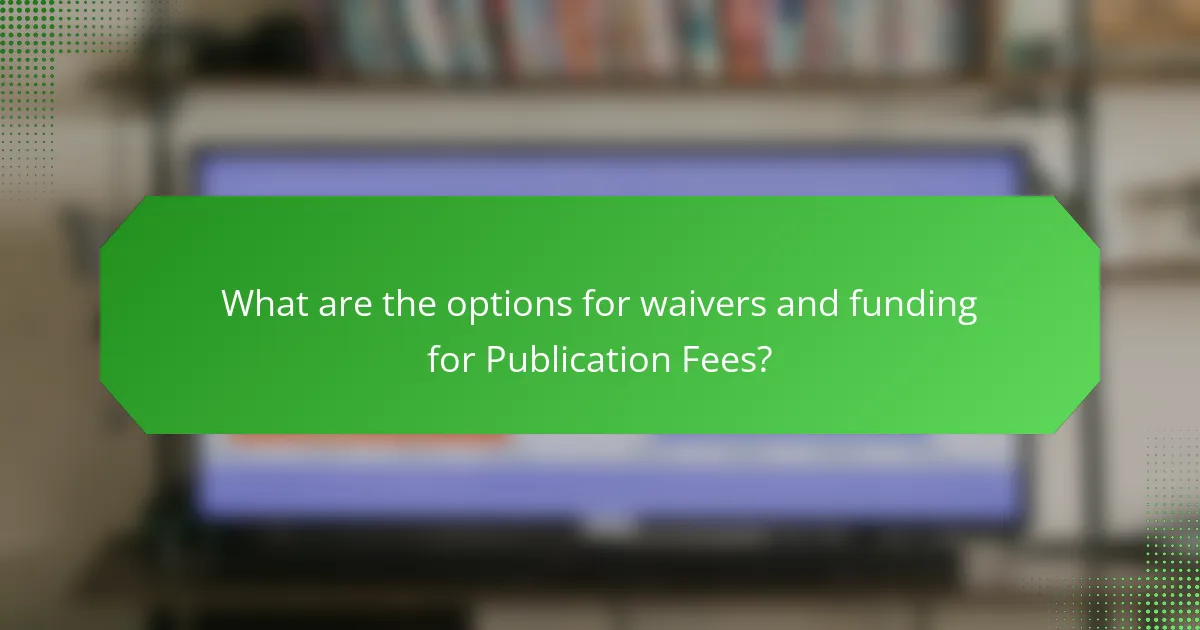
What are the options for waivers and funding for Publication Fees?
Waivers and funding options for publication fees include institutional support, grants, and publisher-specific waivers. Many universities offer funding for their researchers to cover publication costs. Grants from organizations and foundations often include budget allocations for publication fees. Some publishers provide waivers based on financial need or for authors from developing countries. Additionally, open access journals may have specific funding programs to assist authors. Programs like the Wellcome Trust and others also provide funding for publication fees. These options help alleviate the financial burden associated with publishing research.
What types of waivers are available for Publication Fees?
Types of waivers available for publication fees include institutional waivers, financial hardship waivers, and editorial waivers. Institutional waivers are provided by universities or research institutions to support their researchers. Financial hardship waivers assist authors who cannot afford the publication fees due to financial constraints. Editorial waivers are granted at the discretion of the journal’s editorial board, often based on the quality of the submission or the author’s contribution to the field. These waivers aim to promote equitable access to publishing opportunities.
Who qualifies for Publication Fee waivers?
Publication fee waivers are typically available for authors from low-income countries. Researchers who lack institutional funding may also qualify. Additionally, authors facing financial hardship can apply for waivers. Many journals have specific criteria for eligibility, which may include considerations for early-career researchers or those with limited resources. The exact qualifications can vary by journal, so it is essential to check individual journal policies. Journals often provide guidelines on how to apply for these waivers.
How can authors apply for waivers effectively?
Authors can apply for waivers effectively by following specific guidelines. First, they should identify the journal’s waiver policy. Many journals provide detailed information on eligibility criteria for waivers. Next, authors should prepare a clear justification for the waiver request. This justification should explain their financial constraints or lack of funding.
In addition, authors should gather any supporting documentation required by the journal. This may include proof of income or funding status. Authors must submit their waiver request along with their manuscript during the submission process. It’s crucial to adhere to the journal’s deadlines for waiver applications.
Finally, authors should follow up on their request if they do not receive a timely response. This proactive approach can help ensure their waiver application is considered. By following these steps, authors increase their chances of obtaining a waiver for publication fees.
What funding options exist for covering Publication Fees?
Funding options for covering publication fees include institutional grants, research funding, and publisher waivers. Many universities provide grants specifically for publication costs. Researchers can also access funding from government agencies or private foundations. Some journals offer waivers or discounts for authors from low-income countries. Additionally, crowdfunding platforms can help raise funds for publication fees. These options ensure that financial barriers do not hinder academic dissemination.
How can authors access institutional funding for Publication Fees?
Authors can access institutional funding for publication fees through their affiliated institutions. Many universities and research organizations have dedicated funds to support publication costs. Authors should check their institution’s research office or library for specific funding programs. Some institutions require authors to submit a funding request form or grant application. Additionally, authors can inquire about institutional agreements with publishers that may cover fees. It is also beneficial to consult with colleagues or mentors who may have experience in securing such funding. Familiarizing oneself with the institution’s policies on publication funding can streamline the process.
What role do grants and scholarships play in funding Publication Fees?
Grants and scholarships play a crucial role in funding publication fees for researchers and academics. These financial resources help cover the costs associated with publishing in academic journals. Many journals charge publication fees, which can be a barrier for researchers with limited funding. Grants often come from institutions, government bodies, or private organizations specifically aimed at supporting research dissemination. Scholarships may be awarded to individual researchers based on merit or need, facilitating access to publication. According to a study published in “Research Evaluation,” nearly 60% of researchers rely on external funding to cover these fees. Thus, grants and scholarships significantly enhance the ability of scholars to publish their work.
What are best practices for managing Publication Fees?
Establishing a budget is essential for managing publication fees. This budget should account for all potential costs related to publication. Researching various journals and their fee structures helps identify affordable options. Prioritizing open-access journals can increase visibility while managing costs. Seeking institutional support or grants can alleviate financial burdens. Additionally, understanding waiver policies can provide opportunities for fee reductions. Keeping track of submission deadlines ensures timely payments and avoids late fees. Regularly reviewing and adjusting the budget based on actual expenses can improve financial management.
How can authors budget effectively for Publication Fees?
Authors can budget effectively for publication fees by researching potential costs in advance. They should identify the journals they are interested in and review their fee structures. Many journals provide detailed information about publication fees on their websites. Authors can also consider applying for waivers or discounts offered by some journals, especially for researchers from low-income countries. Additionally, authors should explore funding options available through their institutions or grants. Creating a detailed budget that includes all potential expenses will help authors manage their finances better. Tracking expenses and seeking advice from experienced colleagues can provide further insights into effective budgeting strategies.
What tips can help authors navigate Publication Fee negotiations?
Authors should research the publication fee structure of their target journals. Understanding the standard fees helps in negotiations. Authors can also inquire about waivers or discounts for which they may qualify. Communicating openly with journal representatives about budget constraints is essential. Authors should be prepared to justify their requests with specific reasons. It is beneficial to compare fees across similar journals to strengthen negotiation points. Documenting all communications can provide clarity and support during negotiations. Engaging with other authors who have successfully negotiated fees can offer valuable insights.
Publication fees are charges imposed by journals or publishers for processing and disseminating research articles, covering costs such as editorial work and peer review. The article explores how these fees are determined, the factors influencing their costs, and the different types of publication fees, including article processing charges (APCs) and submission fees. It also examines the existence of waivers and funding options available to authors, as well as best practices for managing and budgeting for these fees. Understanding the nuances of publication fees is essential for researchers to navigate the academic publishing landscape effectively.
